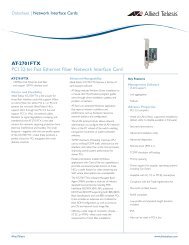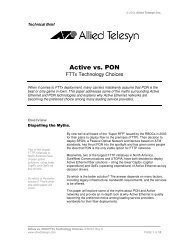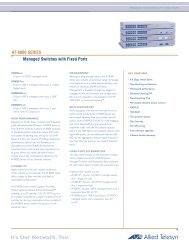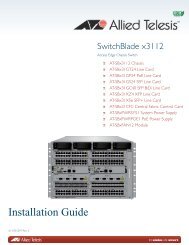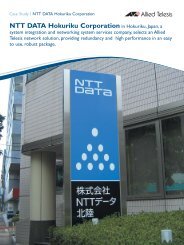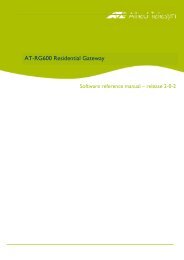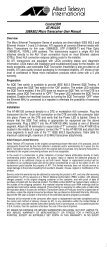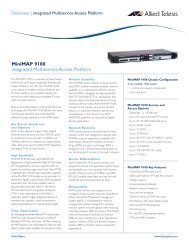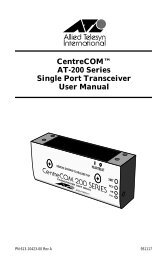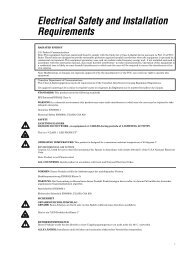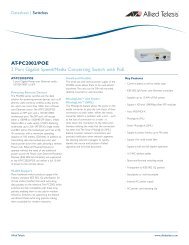SwitchBlade x3112 Installation Guide - Allied Telesis
SwitchBlade x3112 Installation Guide - Allied Telesis
SwitchBlade x3112 Installation Guide - Allied Telesis
Create successful ePaper yourself
Turn your PDF publications into a flip-book with our unique Google optimized e-Paper software.
Chapter 3: Troubleshooting<br />
AT-SBx31XZ4 XFP Line Card Port LED is Off<br />
For fiber optic uplink ports that have an XFP transceiver installed, verify<br />
that the 1000 LINK LED is ON. If a 1000 LINK LED is off but the<br />
transceiver is present, do the following:<br />
<br />
<br />
Verify that the end node connected to the port is powered ON and is<br />
operating properly.<br />
Check that the fiber optic cable is securely connected to the XFP<br />
transceiver in the AT-SBx31XZ4 XFP Line Card and to the port on the<br />
remote end node. The dual ports in an XFP transceiver consist of two<br />
separate connectors, where each connector connects to a separate<br />
fiber strand.<br />
1858<br />
Figure 70. Dual Ports of XFP Transceiver<br />
When you connect a fiber optic cable, be sure that the receive fiber<br />
connector of the XFP transceiver is connected to the transmit<br />
connector on the remote end node, and that the transmit fiber<br />
connector is connected to the receive connector on the remote node.<br />
<br />
<br />
<br />
<br />
<br />
Verify that the XFP transceiver is IEEE 802.3ae (10G Ethernet) and<br />
XFP MSA compliant. If an XFP transceiver meets a “Fiber Channel”<br />
standard, it may not link up.<br />
Verify that the XFP transceiver is completely inserted into the XFP slot.<br />
Make sure that you are using the appropriate type of fiber optic cable<br />
and that the cable length does not exceed the allowed maximum<br />
distance. For cable specifications, refer to the data sheet for your XFP<br />
transceiver.<br />
Use a fiber optic tester to test the attenuation on the cable to<br />
determine if the strength of the fiber optic signal falls below acceptable<br />
limits. For fiber optic port specifications, refer to the data sheet for your<br />
XFP transceiver.<br />
Check that the operating specifications (for instance, wavelength and<br />
maximum operating distance) of the fiber optic port on the remote end<br />
node are compatible with the fiber optic port on the AT-SBx31XZ4 XFP<br />
Line Card.<br />
102



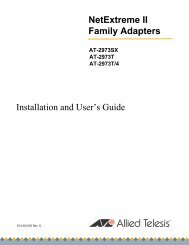
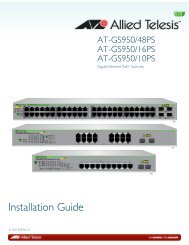
![AT-8100L/8POE-E [Rev B] - Allied Telesis](https://img.yumpu.com/25714603/1/190x245/at-8100l-8poe-e-rev-b-allied-telesis.jpg?quality=85)
